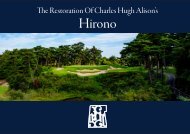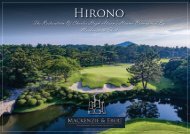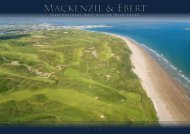Create successful ePaper yourself
Turn your PDF publications into a flip-book with our unique Google optimized e-Paper software.
Introduction & Heritage<br />
Having completed all of the research, one of our main recommendations was to restore the layout and<br />
character of the bunkering although we warned that this would increase the maintenance demands.<br />
<strong>The</strong> members of the Committee were in complete agreement.<br />
<strong>The</strong> Club was also keen to rebuild the greens. Alison had drawn up green plans but the greens had<br />
been rebuilt in the 1980s when they were converted to bent grass. Our belief was that the contours<br />
were probably changed in that process. It was not the easiest task to interpret Alison’s plans but he<br />
defined the general elevations of the greens and the key features, often including quite high mounds<br />
to the rear of the greens. Our knowledge of Colt & Alison courses led us to conclude that Alison would<br />
have wanted more artfully shaped green surfaces. We invited members of the Committee to the British<br />
Isles to see and play some Colt & Alison courses and others where their input was not so significant but<br />
where the greens were good models for <strong>Hirono</strong>. We took them to St. George’s Hill, Swinley Forest, Royal<br />
Cinque Ports, Royal St. George’s, Royal County Down and Royal Portrush and that was very helpful to<br />
debate the shaping of the greens.<br />
We also recommended that the greens should be restored closer to their original sizes and to the<br />
plan shapes which Alison had drawn although his drawings showed greens meeting with bunkers as<br />
was the style at the time. Hence, we were constrained to some extent on this but the greens we have<br />
designed are much larger than those found on our initial visit.<br />
<strong>The</strong> same applied to the fairways. <strong>The</strong>y had become almost ridiculously narrow over the years. We<br />
scaled Alison’s plans and overlaid them. <strong>The</strong>y were enormously wide. <strong>The</strong> 1963 aerial photograph also<br />
showed much wider fairways although not as wide as Alison had drawn. Following consultation with<br />
the Committee, we settled on significant widening of the fairways although there was concern that<br />
this would make the course too easy. We have countered that by adding fairway bunkers to tighten the<br />
landing areas for the better players. While this falls out of the ‘restoration’ concept, we feel that this is<br />
what Alison would recommend if he had the opportunity to revisit the course today with a knowledge<br />
of how the game is now played. That same principle was applied to recommend the removal of some<br />
bunkers which were really no longer relevant, although less so than on most projects of this nature as<br />
the bunkering landscape which Alison imagined is so much a part of the character of <strong>Hirono</strong>.<br />
<strong>The</strong> trees are an interesting subject. <strong>The</strong>re is no doubt that we found too many when we made our<br />
initial visit and that significant clearance was required but the site Alison found did have a significant<br />
amount of woodland and the original course was tree lined to a large degree. Also, some of the trees<br />
which have grown or been planted have added to the beauty of the course.<br />
Golf courses in Japan have a wonderful diversity of character throughout the year. <strong>The</strong> spring sees the<br />
flowering trees, most notably the cherry trees, come to the fore. <strong>The</strong> summer heat and high rainfall<br />
results in a very green and vibrant course. In the autumn, the incredible colours and hues of the maple<br />
trees, which are interspersed amongst the pines, are a marvellous spectacle. Finally, winter takes hold<br />
but, in some ways, the playing conditions are the best and could be described as almost links like. <strong>The</strong><br />
korai (zoysia) fairways turn brown but are so tight and firm running, the noshiba grass rough turns<br />
white and the bent grass greens remain green, providing a very attractive contrast of tones.<br />
Alison’s hole plan for the 18th hole<br />
Alison’s green plan for the 18th hole

















